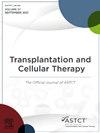Prophylactic Defibrotide in High-Risk Pediatric HSCT: Solution or New Set of Challenges?
IF 3.6
3区 医学
Q2 HEMATOLOGY
引用次数: 0
Abstract
Introduction
Sinusoidal obstructive syndrome (SOS) is a life-threatening complication that can arise after hematopoietic stem cell transplantation (HSCT), especially in high-risk pediatric patients. Despite some understanding of key risk factors, a detailed review of these high-risk groups in the U.S. is essential to better assess the contributing factors, healthcare implications, and patient outcomes associated with prophylactic defibrotide use. Previous studies, including one that was terminated early due to lack of efficacy, have not provided conclusive results on its effectiveness. However, its use persists, making it important to evaluate its real-world efficacy in preventing SOS and its effect on patient outcomes.
Study Design
A retrospective study was conducted on 10,250 patient encounters involving 8,200 unique pediatric patients. The study population was divided into high-risk (n=9,584) and very high-risk (n=666) groups based on the Harmony trial criteria. High-risk patients were defined by factors such as prior transplants, active infections, use of hepatotoxic medications, or advanced disease. Very high-risk patients had multiple risk factors or significant liver dysfunction. The patients were divided into three categories: those who received no defibrotide (n=9,606), prophylactic defibrotide (n=344), and treatment defibrotide (n=683). Data were analyzed for outcomes such as the development of SOS, duration of hospital stays, ICU admissions, mortality rates, and costs. The analysis used a mixed-effects regression model, with statistical significance set at p<0.05.
Findings
In the high-risk group, SOS occurred in 1.4% of patients who did not receive defibrotide compared to 26.5% in those who did. For the very high-risk group, SOS occurred in 2.4% of patients without defibrotide and 31.0% in those with prophylactic use. Median hospital stays for high-risk patients were 32 days in the no defibrotide group vs. 40 days in the prophylactic group (p<0.001). ICU admissions were significantly higher in the prophylactic group (50.7% vs. 30.4%, p<0.001). Mortality was also higher for the prophylactic group (7.9% vs. 2.6%, p<0.001), with increased costs for prophylactic defibrotide patients. Similarly, acute GVHD, infections, and sepsis rates were elevated in the prophylactic group.
Conclusion
Prophylactic defibrotide does not seem to lower the occurrence of SOS in high and very high-risk pediatric HSCT patients. Instead, it is linked to higher rates of ICU admissions, longer hospitalizations, increased mortality, and elevated costs. The findings suggest a need for alternative preventative approaches and additional studies to improve SOS prevention in this patient population.
高危儿童造血干细胞移植预防性去纤肽:解决方案还是新挑战?
鼻窦阻塞综合征(SOS)是造血干细胞移植(HSCT)后可能出现的危及生命的并发症,特别是在高危儿科患者中。尽管对关键的危险因素有一定的了解,但对美国这些高危人群进行详细的回顾对于更好地评估与预防性使用去纤维肽相关的影响因素、保健意义和患者结果是必要的。以前的研究,包括一项因缺乏疗效而提前终止的研究,都没有提供关于其有效性的结论性结果。然而,它的使用仍然存在,因此评估其在预防SOS方面的实际功效及其对患者预后的影响非常重要。研究设计:对10250例患者进行回顾性研究,涉及8200例特殊儿科患者。根据Harmony试验标准,将研究人群分为高危组(n= 9584)和高危组(n=666)。高危患者由诸如既往移植、活动性感染、使用肝毒性药物或疾病晚期等因素定义。高危患者有多种危险因素或明显的肝功能障碍。患者被分为三组:未使用去纤维肽组(n= 9606)、预防性去纤维肽组(n=344)和治疗性去纤维肽组(n=683)。对结果数据进行分析,如SOS的发展、住院时间、ICU入院率、死亡率和费用。分析采用混合效应回归模型,统计学显著性设置为p<;0.05。在高危组中,未接受去纤肽治疗的患者发生SOS的比例为1.4%,而接受去纤肽治疗的患者发生SOS的比例为26.5%。在高危人群中,未使用去纤维肽的患者发生SOS的比例为2.4%,预防性使用去纤维肽的患者发生SOS的比例为31.0%。未使用去纤维肽组高危患者的中位住院时间为32天,而预防性组为40天(p < 0.001)。预防组的ICU入院率显著高于对照组(50.7% vs. 30.4%, p < 0.001)。预防组的死亡率也更高(7.9% vs. 2.6%, p&t;0.001),预防性去纤维肽患者的费用增加。同样,预防组的急性GVHD、感染和败血症发生率升高。结论预防性去纤维肽似乎并不能降低高危儿童HSCT患者SOS的发生。相反,它与更高的ICU入院率、更长的住院时间、更高的死亡率和更高的费用有关。研究结果表明,需要替代的预防方法和额外的研究,以提高该患者群体的SOS预防。
本文章由计算机程序翻译,如有差异,请以英文原文为准。
求助全文
约1分钟内获得全文
求助全文
来源期刊

Transplantation and Cellular Therapy
Medicine-Hematology
CiteScore
7.00
自引率
15.60%
发文量
1061
审稿时长
51 days
 求助内容:
求助内容: 应助结果提醒方式:
应助结果提醒方式:


